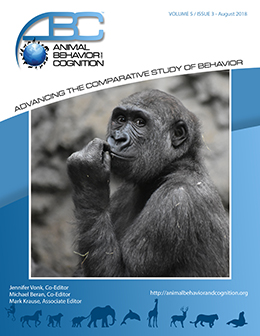Vol 5, Issue 3, August 2018
Visual Processing of Faces in Juvenile Western Lowland Gorillas without the Use of Training or Reinforcement: A Pilot Study
Citation
Chertoff, S., Margulis, S., & Rodgers, J. D. (2018). Visual processing of faces in juvenile western lowland gorillas without use of training or reinforcement: A pilot study. Animal Behavior and Cognition, 5(3), 292–299. https://doi.org/10.26451/abc.05.03.04.2018
Abstract
Cognitive research in zoos is often limited by an inability to consistently train and reinforce subjects. This feasibility study aims to address this problem by examining visual processing of faces by Western lowland gorillas (Gorilla gorilla) at a zoo in order to identify gaze patterns without any training or reward. A Tobii Pro X2-30 eye-tracker mounted on a TV monitor was used. Participation by the gorillas was voluntary in that no training or reinforcement was provided. Two gorillas (a four-year-old female and a one-year-old male) attended sufficiently to the screen to collect gaze data. In order to further validate the calibration procedure used with gorillas, 61 human participants were tested using the same equipment and stimuli. Images were unfamiliar gorilla females with neutral expressions. Areas of interest were identified for the eye region, lower face (mouth and nasal areas), and overall face, and the patterns of fixation to each region were examined. Gorillas tended to focus less on the eyes than did humans. The current results highlight the feasibility of this kind of data collection without the use of training or reinforcement.
Keywords
Gorilla, Human, Eye-tracking, Visual processing
